Deviation From Mendelism
Question 1. A phenomenon in which neither of the alleles of a gene is completely dominant over the other and hybrid is intermediate between the two parents is called
- Incomplete dominance
- Complete dominance
- Codominance
- Complementary dominance
Answer: 1. Incomplete dominance
Incomplete dominance is the phenomenon in which none of the alleles being dominant, and the hybrid produced by crossing two pure individuals is a mixture of the parents.
Question 2. The phenomenon of incomplete dominance was observed by
- De Vries
- Correns
- Tschermark
- None of these
Answer: 2. Correns
- While Mendel’s work laid the foundation, it was German botanist Carl Correns (1864-1933) who was credited with the actual discovery of incomplete dominance.
- In the early 1900s, Correns conducted similar research on four O’ clock plants. In his work, Correns observed a blend of colours in flower petals.
Read And Learn More: NEET Biology Multiple Choice Question And Answers
Question 3. An example of intragenic gene interaction.
- Incomplete dominance
- Codominant
- Multiple alleles
- All of the above
Answer: 4. All of the above
- Post-Mendelian gene interaction involves the influence of alleles and non-alleles on the normal phenotypic expression of genes. It is two types, namely, intragenic (allelic) and intergenic (non-allelic).
- In the intragenic interaction, the two alleles of a gene interact to produce a phenotypic expression different from typical dominant-recessive phenotype, e.g. incomplete dominance, codominance, multiple alleles.
- In intergenic or non-allelic interaction, two or more independent genes present on the same or different chromosomes interact to produce different expression, e.g. epistasis, duplicate genes, complementary genes, supplementary genes, lethal genes, inhibitory genes, etc.
Thus, option (4) is correct.
law of incomplete dominance
Question 4. Genotypic and phenotypic ratio in monohybrid cross remains same in case of
- Sex-linked genes
- Pseudoallelic genes
- Intermediate inheritance
- Dominant and recessive genes
Answer: 3. Intermediate inheritance
Genotypic and phenotypic ratio in monohybrid cross remains same in case of intermediate inheritance.
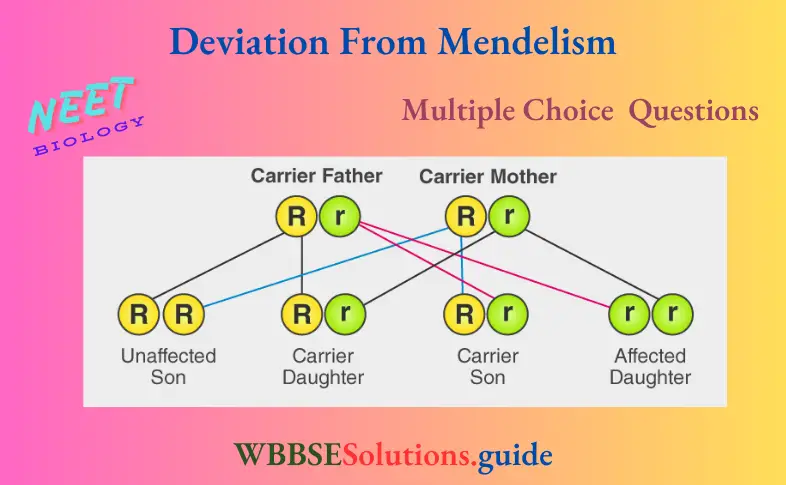
NEET Biology Deviation from Mendelism MCQs with Answers
Question 5. Incomplete dominance is demonstrated in
- Antirrhinum majus
- Pisum sativum
- Hibiscus rosa-sinensis
- Abutilon indicum
Answer: 1. Antirrhinum majus
- Carl Correns reported incomplete dominance in Antirrhinum majus and Mirabilis jalapa. In both the case, there are two types of flower colour in pure state, red and white.
- When the two types of plants are crossed, the hybrid or plants of F1 -generation have pink flowers. The pink colour apparently appears due to mixing of red and white colours (incomplete dominance).
Question 6. Incomplete dominance is shown by
- Primrose
- Mirabilis
- Helianthus
- China rose
Answer: 2. Mirabilis
Question 7. Phenotypic ratio in plant snapdragon in F2 is
- 1: 1
- 2: 1
- 3: 1
- 1: 2: 1
Answer: 4. 1: 2: 1
Phenotypic ratio in snapdragon plant in F2 is 1:2:1.
Question 8. In Mirabilis, a hybrid for red (RR) and white (rr) flower produces pink (Rr) flower. A plant with pink flower is crossed with white flower, the expected phenotypic ratio is
- Red: pink : white (1: 2 : 1)
- Pink: white (1: 1)
- Red: pink (1: 1)
- Red: white (3: 1)
Answer: 2. Pink: white (1: 1)
Mirabilis jalapa shows incomplete dominance.
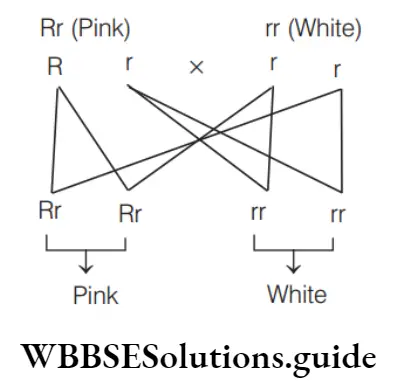
The ratio of pink and white flower is 1:1.
law of incomplete dominance
Question 9. Leaf colour in Mirabilis jalapa is an example of
- Non-Mendelian inheritance
- Mendelian inheritance
- Chemical inheritance
- Both 2 and 3
Answer: 1. Non-Mendelian inheritance
- The inheritance due to the genes found in cytoplasm (mitochondria and chloroplast) is called cytoplasmic inheritance or non-Mendelian inheritance.
- The leaves of Mirabilis jalapa may be green, white or variegated. This is due to cytoplasmic inheritance.
Question 10. RR (red) flowered plant is crossed with rr (white) flowered plant. All of the Rr offspring are pink. This is an indication that the R gene is
- Codominant
- Recessive
- Incompletely dominant
- Linked
Answer: 3. Incompletely dominant
The offspring Rr are pink due to partial expression of both alleles R and r. Thus, the gene R shows incomplete dominance.
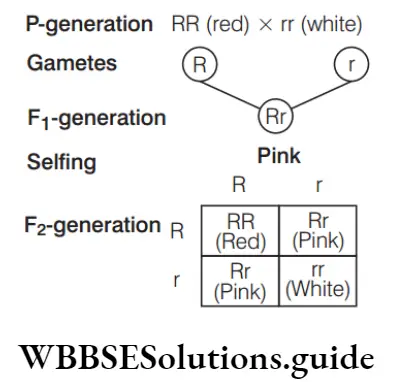
Important MCQs on Deviation from Mendelian Genetics for NEET
Question 11. When phenotypic and genotypic ratio resembles in F2-generation. It is an example of
- Law of segregation
- Law of incomplete dominance
- Complimentary genes
- Epistasis
Answer: 2. Law of incomplete dominance
law of incomplete dominance
Incomplete dominance is not blending inheritance because parental characters reappear in F2-generation. Pink colour flower appear due to incomplete dominance of red colour trait over white flower trait. Both genotypic ratio and phenotypic ratio in the case of incomplete dominance are same, i.e. 1: 2: 1.
Question 12. A blue fowl was obtained after crossing between a white and black fowl. Then the ratio of their F1 – generation will be
- 3: 1
- 9: 7
- 1:2:1
- 13: 3
Answer: 3. 1:2:1
Since the cross between white and black fowl produced an intermediate phenotype, i.e. blue fowl, it is an example of incomplete dominance.
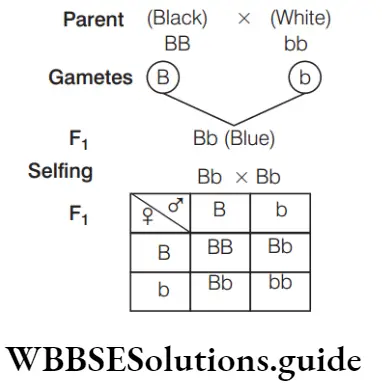
Ratio = 1: 2: 1
Phenotypic ratio 1: 2: 1
(Black: Blue: White)
Genotypic ratio 1: 2: 1 (1BB: 2Bb 1bb)Thus, the correct answer is option (3).
Question 13. Two plants, one with black flower and other with white coloured flower were crossed in an experiment. In the next generation, grey coloured flowers were obtained. The reason for the result is
- Incomplete dominance
- Pseudodominance
- Codominance
- None of the above
Answer: 1. Incomplete dominance
- The expression of the character in a hybrid or F1 individual is intermediate or a fine mixture of the expression of the two alleles of the parents.
- If a plant with black flowers (say BB) on crossing with plant with white flowers (say bb), produced grey coloured flower (Bb), it means that the allele B is incompletely dominant over the recessive allele b. This is an example of incomplete dominance.
Question 14. Starch synthesis gene in pea plant is the example of
- Single gene producing more than one effect
- Multiple genes producing more than one effect
- Two genes producing more than one effect
- Multiple genes producing less than one effect
Answer: 1. Single gene producing more than one effect
- Occasionally, a single gene product may produce more than one effect. For example, starch synthesis in pea seeds is controlled by one gene.
- It has two alleles, B and b. Starch is synthesised effectively by BB and have bigger grains. In contrast, homozygous bb has lesser efficiency in starch synthesis and produce smaller grains.
law of incomplete dominance
Question 15. During the study of incomplete dominance, in a cross between true breeding red flowers (RR) and true breeding white flowers (rr), when F1 was self-pollinated, the resulted F2 ratio may be
- 1 (RR) red: 2 (Rr) pink: 1 (rr) white
- 2 (RR) red: 1 (Rr) pink: 1 (rr) white
- 1 (RR) red: 1 (Rr) pink: 2 (rr) white
- 3 (RR) red: 1 (rr) white
Answer: 1. 1 (RR) red: 2 (Rr) pink: 1 (rr) white
Cross between RR and rr would generate F2 generation as 1 RR: 2 Rr: 1rr.
Question 16. What will be the ratio of F2– generation, if red flowered variety of Mirabilis jalapa is crossed with white flowered variety?
- 1: 1: 1 : 1
- 3: 1
- 1: 2: 1
- 2: 3
Answer: 3. 1: 2: 1
Mirabilis jalapa show incomplete dominance. Thus, the F2-generation would have 1 : 2 : 1 ratio of red, pink and white flowers.
Question 17. The cross which will produce most pink flowers.
- Red × Red
- Red × Pink
- Pink × Pink
- Red × White
Answer: 4. Red × White
Pink colour flower is an intermediate character that is obtained by crossing homozygous red and white flowers.
Question 18. Andalusian fowl shows
- Codominance
- Incomplete dominance
- Multiple alleles
- All of the above
Answer: 2. Incomplete dominance
- Andalusian fowl shows blending inheritance. It is also called as incomplete dominance. In Andalusian fowl, if a cross is made between black feathered fowl and white one, F1 -generation will have a blue feathered fowl.
- After selfing, it produces black-blue and white feathers in the ratio of 1: 2 : 1. Refer to the cross in Ans. 12.
law of incomplete dominance
Question 19. In Antirrhinum, two plants with pink flowers were hybridised. The F1 plants produced red, pink and white flowers in the proportion of 1 red, 2 pink and 1 white. What could be the genotype of the two plants used for hybridisation? Red flower colour is determined by RR and white by rr genes.
- Rrrr
- RR
- Rr
- Rr
Answer: 3. Rr
The genotype of the two plants used for cross would be Rr
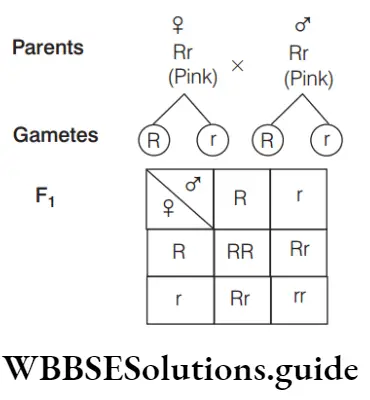
The incomplete dominance of dominant allele (here R) over recessive allele (here r) could be due to mutations (insertion, deletion, substitution or inversion of nucleotides). The mutant allele generally produces a faulty or no product.
Question 20. All of given options obeys Mendel’s laws except
- Codominance
- Independent assortment
- Dominance
- Purity of gametes
Answer: 1. Codominance
In the given options, only codominance does not obey Mendel’s laws of dominance. It is an example of non-Mendelian intragenic interaction.
Question 21. When both alleles of a pair are fully expressed in a heterozygote, they are called
- Lethal
- Codominants
- Semidominants
- Recessive allele
Answer: 2. Codominants
law of incomplete dominance
- Codominance is the condition that arises when both alleles in a heterozygous organism are dominant and are fully expressed in the phenotype.
- For example, the human blood group AB is the result of two alleles, A and B, both being expressed equally A is not dominant to B, nor vice-versa.
Question 22. A gene showing codominance has
- Alleles that are recessive to each other
- Both alleles independently expressed in the heterozygote
- One allele dominant on the other
- Alleles tightly linked on the same chromosome
Answer: 2. Both alleles independently expressed in the heterozygote
Incomplete Dominance and Codominance MCQs for NEET
Question 23. Which Mendelian idea is depicted by a cross in which the F1 – generation resembles both the parents?
- Law of dominance
- Inheritance of one gene
- Codominance
- Incomplete dominance
Answer: 3. Codominance
In codominance, F1 -generation resembles both the parents, e.g. blood group inheritance.
Question 24. Assertion (A) There are cows of two colour coats. Reason (R) It is the case of codominance.
- Both A and R are true and R is the correct explanation of A
- Both A and R are true, but R is not the correct explanation of A
- A is true, but R false
- Both A and R are false
Answer: 1. Both A and R are true and R is the correct explanation of A
Both A and R are true and R is the correct explanation of A. There are cows of two colour coats, which is only possible in case of codominance where character of both the alleles are expressed.
Question 25. Identify the wrong statement.
- Alleles b and c also produce sugar
- Alleles IA and IB produce sugars
- When IB and b or i are present only IB is expressed
- Both IA and IB are present together and they express because of codominance
Answer: 1. Alleles b and c also produce sugar
- Statement in option (1) is wrong because AB blood group in humans is controlled by three multiple alleles, i.e IA , IB and i.
- The IA and IB alleles produce enzyme glycosyl transferase for the synthesis of sugars. Allele i does not produce any enzyme/antigen.
- Both IA and IB are codominant and these both are dominant over i. Since, b and c represent recessive forms, they cannot produce sugar. Rest statements are correct.
Question 26. An example for codominance is
- Eye colour in Drosophila
- Seed shape and colour in pea plants
- AB blood group in man
- Haemophilia in man
- Baldness in man
Answer: 3. AB blood group in man
The phenomenon of expression of both the alleles in a heterozygote is called codominance. Alleles for blood group A (IA ) and for blood group B (IB) are codominant, so that when they come together in an individual, they produce blood group AB.
law of incomplete dominance
Question 27. Blood grouping in humans is controlled by
- 4 alleles in which A is dominant
- 3 alleles in which AB is codominant
- 3 alleles in which none is dominant
- 3 alleles in which A is dominant
- None of the above
Answer: 2. 3 alleles in which AB is codominant
The three alleles controlling the human blood groups are IA ,IB,IO in which AB is codominant.
Question 28. A child of blood group O cannot have parents of blood groups
- AB and AB/O
- A and B
- B and B
- O and O
Answer: 1. AB and AB/O
A child of blood group O cannot have parents of blood groups AB and AB/O.
AB blood group possesses the genotype IA IB. AB × AB would generate blood groups A, B or AB.
AB × O would generate blood groups A or B, but never O. In the presence of dominant alleles, recessive allele (i) cannot be expressed.
Question 29. If mother has ‘O’ blood group, child also has O group. What will be the blood group of father?
- O
- A
- B
- All of these
Answer: 4. All of these
law of incomplete dominance
The cross between blood group O and either O, A or B can produce progeny with blood group O. But in such condition, father should have heterozygous genotype (in case of blood group A or B).
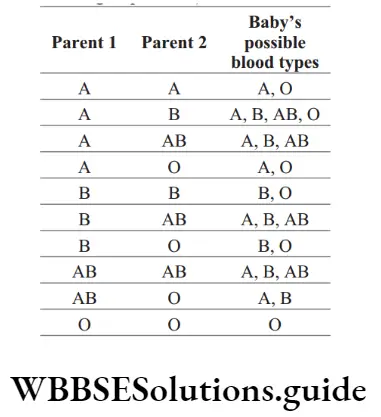
Thus, option 4 is correct.
Question 30. First husband of Asha had ABO blood type A and their child had type O. She remarried and her second husband had ABO blood type B and their child had type AB. What is the ABO genotype of Asha and also name her blood type?
- Ii, blood type O
- IB, blood type B
- IAIB, blood type AB
- IAi, blood type A
Answer: 4. IAi, blood type A
- Asha’s child from her first husband had blood group type O, i.e. genotype (ii). It means that the child received two recessive alleles, one from each of his parents (i from father and i from mother Asha).
- Asha’s child from second husband had blood group type AB, i.e. genotype IA IB. As the child’s father had blood group type B (genotype
IBi/IBIB), it means that the child received IB allele from father and IA allele from Asha. - Above discussion makes it clear that Asha’s blood group type contains i and I A genes, thus her blood group type is A with genotype IA i.
law of incomplete dominance
Question 31. In the ABO blood group system in humans, if a person of type B blood has children with a person of type AB blood, what blood types could their children have?
- Type-AB, type-A and type-B
- Type-B and type-AB
- Type-AB, type-A, type-B and type-O
- Type-A and type-B
Answer: 1. Type-AB, type-A and type-B
Since, A and B alleles are codominant, the possible blood types of the children are type-AB, type-A and type-B.
Topic-wise Deviation from Mendelian Genetics MCQs for NEET with Explanation
Question 32. ABO blood group is determined by three different alleles. How many genotypes and phenotypes are possible? Genotypes Phenotypes
img
Answer: 2. 6 4
The 3 alleles IA , IB and i of gene I in ABO blood group system can produce six different genotypes and four different phenotypes as shown below
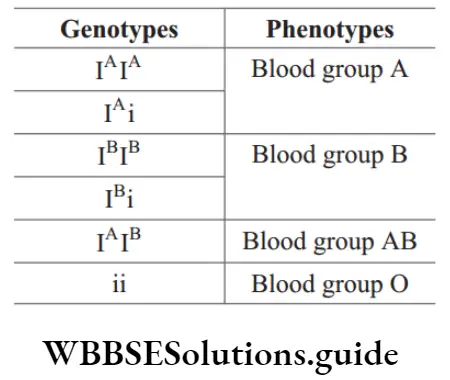
Question 33. A man with A group of blood marries a woman with B group of blood. The possibility of blood group AB in their children will be
- 25%
- 75%
- 50%
- 100%
Answer: 1. 25%
- In this case, the genotype of the partner with ‘A’ blood group will be either IA IA or IA 1. The genotype of the partner with ‘B’ blood group will be either IBIB or IBi.
- The progeny can have all the four types of blood groups 25% O (2), 25% A (IA IA or IA i), 25% B (IB IB or IBi) and 25% AB (IA IB).
Question 34. A child of O group has B group father. The genotype of father will be
- IOIO
- IBIB
- IAIB
- IBIO
Answer: 4. IBIO
The genotype of the child with O blood group would be IOIO (recessive). Hence, the genotype of the father can only be I IB O, i.e. heterozygous B blood group.
Question 35. When both the parents are of blood group AB, children would be of blood group
- A, B, AB and O
- A, B and AB
- A and B
- A, AB and O
Answer: 2. A, B and AB
When both parents have blood group AB (IA IB) then offspring can have blood group A, B and AB.
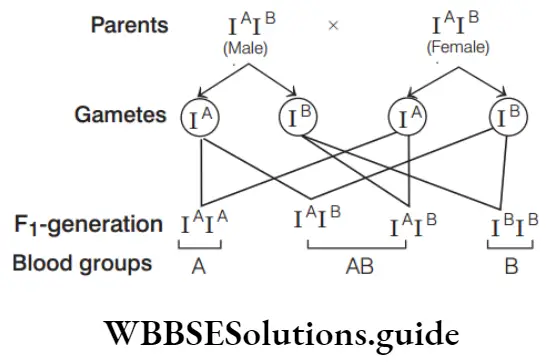
law of incomplete dominance
Question 36. Children have A and B types of blood. What are the blood types of parents?
- A and O
- AB and A
- AB and O
- A and B
Answer: 3. AB and O
Among given options, only AB and O can produce both A and B blood type in progeny.
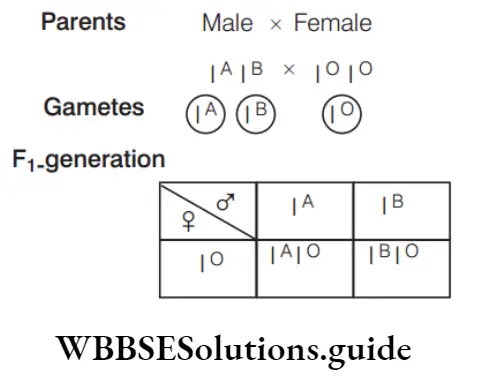
So, blood types of parents are AB and O.
Question 37. Blood group B can have alleles
- Ii
- IAIA
- IBIB
- IBIB or IBi
Answer: 4. IBIB or IBi
Blood group B can have two types of genotype. It can be found in homozygous (I IB B) or in heterozygous (I iB ) condition.
Question 38. If one parent belongs to A blood group and the other to O blood group, their children possibly represent
- A and B groups only
- AB only
- A and O groups only
- All four groups
Answer: 3. A and O groups only
Children with parents having blood groups A and O will have blood groups either A or O.
Question 39. Assertion (A) A woman can go to the court if a man refuses to own his child. He has blood group B and women has A, while child has O. Reason (R) Genetically she is right, he can be father of the child.
- Both A and R are true and the R is the correct explanation of A
- Both A and R are true, but R is not the correct explanation of A
- A is true, but R false
- Both A and R are false
Answer: 1. Both A and R are true and the R is the correct explanation of A
Both A and R are true and R is the correct explanation of A. Man has blood group B, it means he will have alleles I IB B or I IB O and woman has blood group A, that can have alleles I IA A or I IA O.
So there is possibility of a producing child with blood group O. In such condition, both man and woman are heterozygotes and have blood group genotype I IB 0 and I IA 0, respectively.
Question 40. Which of the following genotypes does not produce any sugar polymer on the surface of the RBC?
- IAIA
- IBi
- IAIB
- Ii
- IBIB
Answer: 4. Ii
Genotype ii does not produce any sugar polymer on the surface of the RBC because it is recessive allele. The blood group associated with this genotype is O.
Question 41. The genotypes of a husband and wife are I AI B and I A i. Among the blood types of their children, how many different genotypes and phenotypes are possible?
- 3 genotypes, 3 phenotypes
- 3 genotypes, 4 phenotypes
- 4 genotypes, 3 phenotypes
- 4 genotypes, 4 phenotypes
Answer: 3. 4 genotypes, 3 phenotypes
Mating between I IA B and I iA can produce 4 genotypes and 3 phenotypes as shown in cross given below.
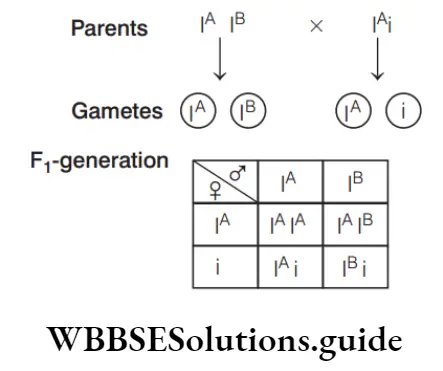
law of incomplete dominance
Question 42. A man of A blood group marries a woman of AB blood group. Which type of progeny would indicate that man is heterozygous?
- O
- B
- A
- AB
Answer: 2. B
- Possible blood groups of children born to parents having A and AB groups are A, B and AB. These parents cannot have children possessing O group of blood.
- AB blood group parent is always a heterozygote, while A blood group parent can either be a homo or heterozygote. If the male parent with blood group A in question is homozygote then no child with blood group B will be born.
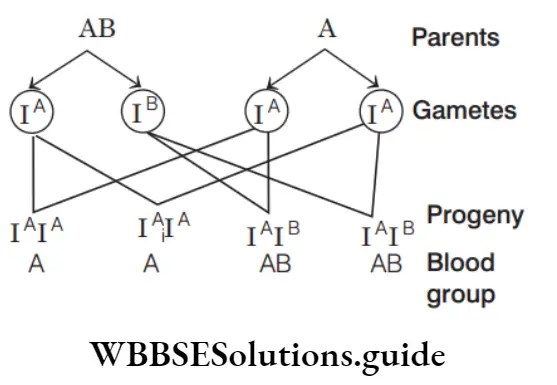
When the male parent is heterozygote then only blood group B of progeny shows that male parent is heterozygous.
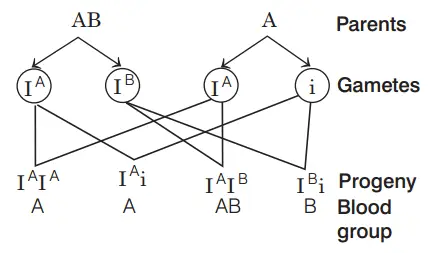
Question 43. Four children belonging to the same parents have the following blood groups A, B, AB and O. Hence, the genotypes of the two parents are
- Parents are homozygous for ‘A’ group
- One parent is homozygous for ‘A’ and another parent is homozygous for ‘B’
- One parent is heterozygous for ‘A’ and another parent is heterozygous for ‘B’
- Parents are homozygous for ‘B’ group
Answer: 3. One parent is heterozygous for ‘A’ and another parent is heterozygous for ‘B’
Four children belonging to the same parents will have the blood groups A, B, AB and O, if the genotypes of one parent is heterozygous for ‘A’ (IA IO) and another parent is heterozygous for ‘B’ (IBIO). It is illustrated below
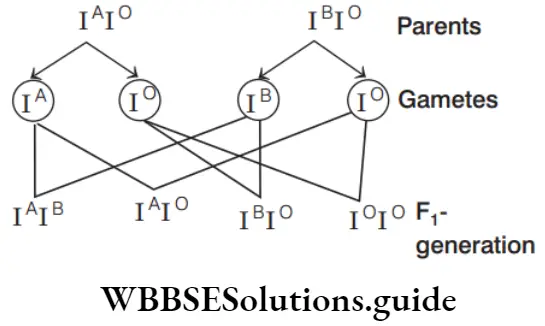
IA IB = AB blood group
IA IO = A blood group
IBIO= B blood group
IOIO = O blood group
Question 44. With regard to the ABO blood typing system, if a man who has type B blood and a woman who has type A blood were to have children, what blood types could the children have?
- A or O
- B or O
- AB or O
- A, B, AB or O
Answer: 2. B or O
The man has type B blood and woman has type O blood. So, the genotype of their blood group will be IBIB or IBIO and IOIO, respectively. The blood type of child will be either B or O. This is illustrated below
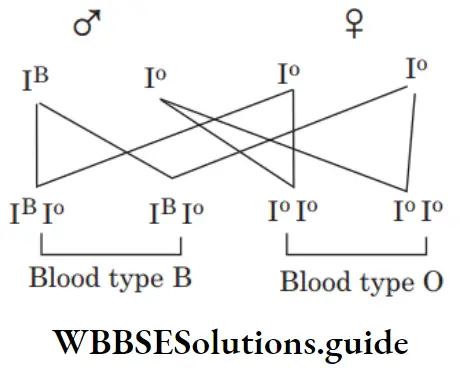
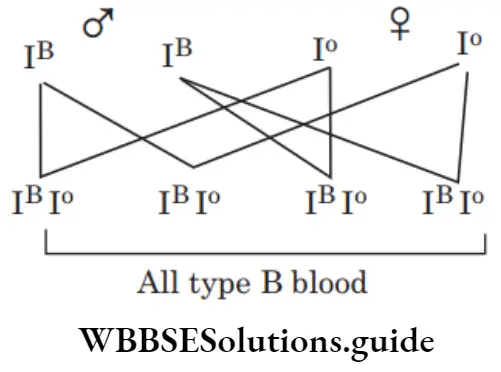
law of incomplete dominance
Question 45. Percentage of blood groups in India is given in the diagram below.
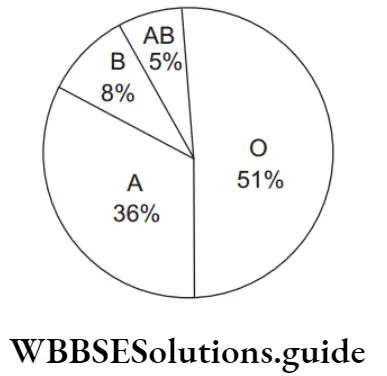
- Choose the correct option from the given statements.
- Only 10% of individuals are heterozygous for blood group allele
- Group A is the most common as it is the homozygous recessive group
- The alleles for blood group A and O are dominant to the allele for blood group O
- Any individual, selected at random from the sample population, has a 1 in 20 chance of being blood group AB
Answer: 4. Any individual, selected at random from the sample population, has a 1 in 20 chance of being blood group AB
As given in the pie chart, the AB blood group percentage is 5% in India. So, it can be said that any individual, selected at random from sample population has 1 in 20 chance of being blood group AB.
Question 46. A child’s blood group is ‘O’. The parent’s blood groups cannot be
- AB
- A and B
- B and O
- A and A
- None of these
Answer: 1. AB
A child’s blood group is ‘O’, i.e. it has no antigen, but group AB possess both the antigen A and B. Thus, it is not possible for the ‘O’ blood group individual to have parents with blood group AB. It is illustrated in cross given below
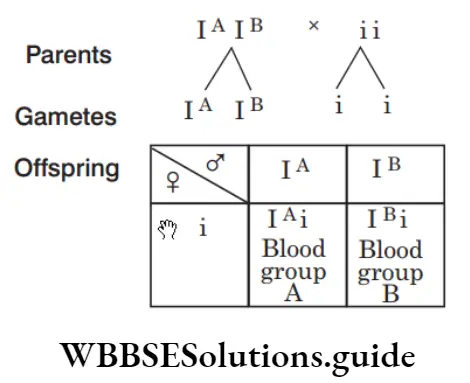
NEET Biology Multiple Allelism and Pleiotropy MCQs
Question 47. Most popularly known blood grouping is the ABO grouping. It is named ABO and not ABC, because ‘O’ in it refers to having
- Overdominance of this type on the genes for A and B types
- One antibody only either anti-A or anti-B on the RBCs
- No antigens A and B on RBCs
- Other antigens besides A and B on RBCs
Answer: 3. No antigens A and B on RBCs
In ABO blood group, O refers to O blood group that has no antigen (A and B) on RBCs.
Question 48. The father has blood group AB and mother ‘O’. The child is supposed to have which of the following blood groups?
- B or O
- A or B
- Only B
- Only A
Answer: 2. A or B
- The father has blood group ‘AB’ and mother has ‘O’. The child is supposed to have blood group ‘A’ or ‘B’. The genotype of father having blood group AB will be IA IB.
- The genotype of mother having blood group O will be ii. Group ‘O’ blood has no antigens on RBC and has anti A and anti – B antibodies in serum.
- Blood group AB has antigens A and B (but no antibodies in serum), thus the offsprings of AB and O blood groups would be ‘A’ or ‘B’. Refer to cross in Ans. 46.
Question 49. Which of the following characteristics represent ‘inheritance of blood groups’ in humans?
- Dominance
- Codominance
- Multiple allele
- Incomplete dominance
- Polygenic inheritance
Choose the correct answer
- 2, 3 and 5
- 1, 3 and 5
- 2, 4 and 5
- 1, 2 and 3
Answer: 4. 1, 2 and 3
- Inheritence in the human blood group shows multiple alleles, dominance as well as codominance. Within the ABO blood group system, the A and B gene are codominant, i.e. these are expressed equally whenever present together. The O gene is recessive and only expressed when neither A nor B is present.
- Three alleles are responsible for the different types of blood groups in human which shows multiple allelism. Alleles IA and IB show dominance on allele i.
Question 50. Parents of blood groups O and AB cannot have a child of group AB because
- Gene O is dominant over gene A
- Gene O is dominant over gene B
- Gene A or B is absent in one of the parents
- Gene A and B are absent in one of the parents
Answer: 3. Gene A or B is absent in one of the parents
Parents of blood group O and AB cannot have a child of group AB because gene A or B is absent in one of the parents. Refer to Ans. 46.
law of incomplete dominance
Question 51. An individual with genotype I BIO has blood group
- A
- B
- AB
- O
Answer: 2. B
An individual with genotype I IB O has blood group B. As per law of dominance, allele IB is dominant and it will be expressed, whereas allele IO being recessive would not be expressed.
Question 52. If two people with ‘AB’ blood group marry and have sufficiently large number of children these children could be classified as ‘A’ blood group: ‘AB’ blood group: ‘B’ blood group in 1 : 2 : 1 ratio. Modern technique of protein electrophoresis reveals presence of both ‘A’ and ‘B’ type proteins in ‘AB’ blood group individuals. This is an example of
- Incomplete dominance
- Partial dominance
- Complete dominance
- Codominance
Answer: 4. Codominance
- ABO blood group system in human beings is an example of codominant, dominant–recessive and multiple alleles.
- Blood groups are controlled by the gene I located on 9th chromosome that has 3 multiple alleles, out of which any two are found in a person.
- In codominance, both genes I IA and B express completely. So, given example in question is an example of codominance.
Question 53. An exception to Mendel’s law is
- Law of independent assortment
- Law of segregation
- Law of dominance
- Law of linkage
Answer: 4. Law of linkage
Linkage is the tendency of two or more genes to inherit together. Mendel’s laws are true only in the absence of linkage and gene interaction. Thus, linkage is an exception to Mendel’s law.
Question 54. Choose the incorrect one out.
- Codominant genes are never haplosufficient
- Dominant phenotype is expressed when a gene is haplosufficient
- Incomplele dominance is the presence of haplosufficiency
- In homozygous condition, an allele can express its phenotype be it the dominant or recessive allele in nature
Answer: 3. Incomplele dominance is the presence of haplosufficiency
Option (3) is incorrect and can be corrected as Haplosufficiency is the condition when an allele can express itself fully and produce its phenotype completely even in heterozygous condition. Incomplete dominance results from lack of haplosufficiency. Rest all options are correct.
Question 55. Failure in which of the following phenomenon would result in linkage?
- Law of dominance
- Law of segregation
- Law of independent assortment
- Law of separation
Answer: 3. Law of independent assortment
Failure of independent assortment would result in the linkage of genes on the chromosomes. Due to this, the two alleles present closely together fails to seggregate during gamete formation and thus inherit together.
law of incomplete dominance
Question 56. In genetic crosses showing recessive epistasis such as mice coat colour, F2 phenotypic ratio is
- 9 : 3: 4
- 9 : 6: 1
- 12 : 3: 4
- 13 : 3
Answer: 1. 9 : 3: 4
- Epistasis due to recessive gene is known as recessive epistasis, i.e. out of the two pairs of genes, the recessive epistatic gene masks the activity of the dominant gene on the other gene locus.
- In genetic crosses showing recessive epistasis such as mice coat colour, F2 phenotypic ratio is 9 : 3: 4.
Question 57. In a dihybrid cross, between two heterozygotes AaBb : AaBb, if we get 3:1 ratio among the offsprings, the reason for this may be
- Polygenes
- Linked genes
- Pleiotropic genes
- Hypostatic genes
Answer: 2. Linked genes
- In case of dihybrid cross between AaBb × AaBb, if we get 3:1 ratio among the offsprings then it may be due to the presence of linked genes.
- These genes are placed on the same chromosome and do not show independent assortment at the time of gamete formation. These genes show a dihybrid ratio of 3: 1. Complete linkage allows the gene combination of parental traits to be inherited together.
Question 58. TtRr represents heterozygous tall, heterozygous pink. If this plant is self-crossed then (T-dominant, t-recessive, R-dominant, r-recessive)
- 25% plants have red flower.
- 25% plants have white flower.
- 50% plants have pink flower.
- 50% plants are tall.
Choose the correct option.
- 1 and 2
- 1, 2 and 3
- 2, 3 and 4
- 1, 2,3 and 4
Answer: 2. 1, 2 and 3
TtRr represents (heterozygous tall and pink). Hence, in accordance with the ratio of incomplete dominance, i.e. 1 : 2 : 1, 25% plants have red flower, 25% plants have white flower and 50% plants have pink flower.
Question 59. The F2 dihybrid ratio 12:3:1 is explained on the basis of
- Epistatic interaction
- Complementary gene action
- Interaction between two alleles
- Both 1 and 2
Answer: 1. Epistatic interaction
Epistasis is a type of gene interaction in which one gene masks or prevents the expression of another. Such interactions give modified F2 ratio as 12: 3 : l.
Question 60. Which of the following ratio shows complementary gene interaction?
- 9:7
- 15:1
- 1:2:1
- 9:3:3:1
Answer: 1. 9:7
Complementary gene interaction was first discovered by William Bateson and Reginald Punnett in 1906.
9:7 ratio shows that 9 offspring have both dominant genes, while 7 is having either one dominant or both recessive genes.
Question 61. Independent assortment of genes does not takes place when
- Genes are located on homologous chromosomes
- Genes are linked and located on same chromosome
- Genes are located on non-homogenous chromosome
- All of the above
Answer: 2. genes are linked and located on same chromosome
Genes that are located on the same chromosome are not free to participate in independent assortment and are referred to as linked genes. These genes tend to be inherited together.
Question 62. Lack of independent assortment of two genes, A and B in fruitfly, Drosophila is due to
- Repulsion
- Recombination
- Linkage
- Crossing over
Answer: 3. Linkage
Lack of independent assortment of two genes, A and B in fruitfly Drosophila is due to linkage, in which genes are located close to each other and they do not assort independently.
Question 63. When two dominant independently assorting genes react with each other, they are called
- Collaborative genes
- Complementary genes
- Duplicate genes
- Supplementary genes
Answer: 2. Complementary genes
law of incomplete dominance
Two genes present on separate loci that interact together to produce a dominant phenotype are called complementary genes. In F2 -generation, 9:7 ratio is obtained by them.
Question 64. Multiple phenotype is seen in
- Dominance relationship
- Particulate inheritance
- Monogenic inheritance
- Polygenic inheritance
Answer: 4. Polygenic inheritance
- Polygenic inheritance is a type of inheritance controlled by one or more genes in which the dominant alleles have cumulative effect with each dominant allele expressing a part or unit of the trait and the full trait being shown only when all the dominant alleles are present.
- The genes involved in quantitative inheritance are called polygenes (also called cumulative genes). Quantitative inheritance is therefore, also called polygenic inheritance. It is also named as multiple factor inheritance as mutiple phenotypes are seen in it.
Cytoplasmic Inheritance and Gene Interaction MCQs for NEET
Question 65. Skin colour inheritance in man is
- Monogenic
- Polygenic
- Sex-linked
- Multiple alleles
- Epistasis
Answer: 2. Polygenic
Inheritance of skin colour in man is an example of polygenic inheritance. It shows cumulative effect, i.e. two independent dominant genes produce additive effect in an individual.
Question 66. Who gave first experimental evidence of the polygenic concept of inheritance?
- Galton (1883)
- Malthus (1828)
- Nilsson Ehle (1908)
- None of the above
Answer: 3. Nilsson Ehle (1908)
Continuous variation is due to the additive effect of two or more genes for a trait. Such type of inheritance is called polygenic inheritance. Nilsson Ehle gave first experimental evidence of the polygenic concept of inheritance.
Question 67. The total number of types of gametes produced in a cross between a negro and albino parent is
- 64
- 16
- 08
- 04
Answer: 3. 08
The F1 -generation has mullatoes with 8 types of gametes. The genetic combination is AaBbCc. As there are three pairs of heterozygous alleles, it will form 8 types of gametes.
Question 68. Select the statement which is not correct?
- Polygenic character is controlled by multiple alleles
- In case of polygenic inheritance, thousands of intermediate phenotypes are found between 2 extreme ones
- Height, weight, skin colour are polygenic
- Polygenic character is controlled by multiple genes
Answer: 1. Polygenic character is controlled by multiple alleles
- Statement in option (1) is not correct. Quantitative or polygenic inheritance is that type of inheritance in which the complete expression of a trait is controlled by two or more genes.
- The complete trait develops only by the cumulative effect of all homologous and non-homologous dominant alleles influencing that trait. Inheritance of skin colour in man is an example of polygenic inheritance. Rest all options are correct.
Question 69. The polygenic genes show
- Similar genotype
- Different karyotype
- Different phenotype
- None of the above
Answer: 4. None of the above
A polygenic trait is governed by more than one gene where dominant allele of each gene express a part of trait and full trait is expressed by dominant alleles of all genes. Depending upon genotype, it produce multiple or different phenotypes.
Question 70. Which one of the following pairs of features is a good example of polygenic inheritance?
- Human height and skin colour
- ABO blood group in humans and flower colour of Mirabilis jalapa
- Hair pigment of mouse and tongue rolling in humans
- Human eye colour and sickle-cell anaemia
Answer: 1. Human height and skin colour
Statement in option (a) is a good example of polygenic inheritance as Inheritance of human height and skin colour are examples of polygenic inheritance. Rest all options are false.
Question 71. The phenotypic ratio of polygenes representing skin colour in human is
- 1: 4 : 6: 4: 1
- 1: 2: 1
- 1: 6: 15: 20 : 15: 6: 1
- 1: 3: 1
Answer: 3. 1: 6 : 15: 20 : 15: 6: 1
The phenotypic ratio of polygenes representing skin colour in human is
1 : 6 : 15 : 20 : 15 : 6 : 1.
Question 72. Grain colour in wheat is determined by three pairs of polygenes. Following the cross AABBCC (dark colour) × aabbcc (light colour) in F2-generation. What proportion of the progeny is likely to resemble either parent?
- Half
- Less than 5%
- One third
- None of these
Answer: 2. Less than 5%
- Polygene results in quantitative inheritance. This inheritance is characterised by the occurrence of intermediate forms between the parental types. There will be 7 phenotypes (l: 6: 15: 20: 15: 6: 1) when three polygene pairs are involved.
- The total number of progeny would be 64. Out of these 64, only two are likely to resemble either parent. Hence, their proportion in F2-generation would be less than 5%.
law of incomplete dominance
Question 73. Multiple factor inheritance has been observed in which of the following characteristic of wheat?
- Height of the plant
- Colour of the grain
- Shape of legumes
- Number of spikelets
Answer: 2. Colour of the grain
A few instances of multiple factor inheritance are kernel or grain colour in wheat, cob length in maize, yield of crop plants including size, shape and number of seeds or fruits per plant.
Question 74. Which of the following is not the type of epistasis?
- Dominant
- Recessive
- Collaborative
- Supplementary
Answer: 3. Collaborative
All given options are types of epistasis except collaborative. Epistasis can be of many types based on the ability of an allele in masking and modification of gene effects. It can be of dominant, recessive, complementary or supplementary.
Question 75. Assertion (A) A gene affecting the character of another gene not located on similar locus of the homologous chromosome is called epistatic gene. Reason (R) Epistatic gene hides the expression of an allele at a different locus.
- Both A and R are true and R is the correct explanation of A
- Both A and R are true, but R is not the correct explanation of A
- A is true, but R is false
- Both A and R are false
Answer: 1. Both A and R are true and R is the correct explanation of A
Question 76. The process that involves intergenic suppression or the masking effect which one gene locus has upon the expression of another is called
- Epistasis
- Dominance
- Incomplete dominance
- Recessive
- Pleiotropy
Answer: 1 . Epistasis
- Originally, the term epistasis meant that the phenotypic effect of one gene is masked by a different gene (locus).
- Thus, epistatic mutations have different effects in combination, than individually. In epistasis, two independent non-allelic genes affect the same trait in such a way that one overmasks the expression of other.
Question 77. A pleiotropic gene
- Controls a trait only in combination with another gene
- Controls multiple traits in an individual
- Is expressed only in primitive plants
- Is a gene evolved during Pliocene
Answer: 2. Controls multiple traits in an individual
- The ability of a gene to have multiple phenotypic effects because it influences a number of characters simultaneously is known as pleiotropy.
- The gene having a multiple phenotypic effect because of its ability to control expression of two or more characters is called pleiotropic gene.
- In human beings, pleiotropy is exhibited by syndromes like sickle-cell anaemia and
phenylketonuria.
Question 78. Assertion (A) The phenomenon of a single gene influencing more than one character is pleiotropism. Reason (R) The gene responsible for phenylketonuria affects a number of abnormal phenotypic traits.
- Both A and R are true and R is the correct explanation of A
- Both A and R are true, but R is not the correct explanation of A
- A is true, but R false
- A is false, but R is true
- Both A and R are false
Answer: 2. Both A and R are true, but R is not the correct explanation of A
Both A and R are true, but R is not the correct explanation of A. The phenomenon of a single gene influencing more than one character is pleiotropism and phenylketonuria is its example.
Linked Genes and Crossing Over MCQs for NEET
Question 79. Pleiotropic genes have
- Repressed phenotype
- Hidden phenotype
- Multiple phenotype
- All of the above
Answer: 3. Multiple phenotype
Pleiotropic gene is such a gene which has a wider effect on phenotype, i.e. it controls several phenotypic, traits. It has mutliple phenotypes. Sickle-cell anaemia is caused by one such pleiotropic gene.
Question 80. The best example for pleiotropy is
- Skin colour
- Phenylketonuria
- Colour blindness
- ABO blood group
Answer: 2. Phenylketonuria
- The best example for pleiotropy is phenylketonuria. In phenylketonuria, a single gene mutation that codes for enzyme phenylalanine hydrodxylase is seen.
- This manifests itself through phenotypic expression characterised by mental retardation, reduction in hair and skin pigmentation.
Question 81. Name the phenomenon where two genes have the same expression of the character?
- Pleiotropy
- Phenocopy
- Penetrance
- Expressivity
Answer: 1. Pleiotropy
Pleiotropy is the condition where either a single gene has multiple functions in the body or two genes have the same expression of the single character.
Question 82. Match the following columns.
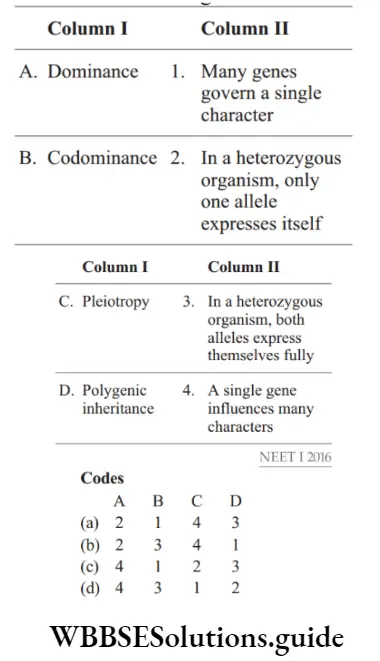
Answer: 2. A–2, B–3, C–4, D–1
law of incomplete dominance
Question 83. The presence of continuous phenotypic variation in an F1 -generation suggests that a character is inherited by
- Gene linkage
- Epistasis
- Polygenic inheritance
- Recombination
Answer: 3. Polygenic inheritance
- Quantitative or polygenic inheritance is that type of inheritance in which the complete expression of a trait is controlled by two or more genes (i.e. the presence of continuous phenotypic variation in an F1 -generation).
- The complete trait develops only by the cumulative effect of all homologous and non-homologous
dominant alleles influencing that trait. Inheritance of skin colour in man is an example of polygenic inheritance.
